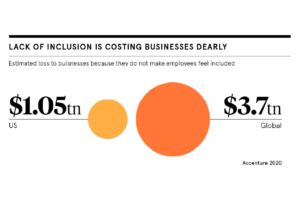
Driving genuine diversity and inclusion
August 19, 2021
Six Part Series, Part 1: Why non-inclusive companies fail
As diversity and inclusion (D&I) come into ever-sharper focus, an inclusive workforce is no longer an optional nice-to-have, but integral to an organization’s survival.
“Inclusion is not a matter of political correctness. It is the key to growth,” said the Reverend Jesse Jackson back in 2007. In 2021, the business case for diversity is clear. Companies that are more diverse perform better financially, are more productive and have better access to in-demand talent.
Don’t believe us? Ask the experts. The 2020 McKinsey Diversity Matters study found that companies in the top quartile of gender diversity were 25% more likely to experience above average profitability than those in the bottom quartile. Companies in the top quartile for ethnic or cultural diversity were 36% more likely to outperform on profitability than those in the bottom quartile. In fact, the higher the level of representation, notably 30% women on the board versus 10%, the better the performance.

But it’s not just about diversity at a demographic level; it’s about diverse thinking. Research by Deloitte shows the diversity of thought is just as important to an organization’s future, with cognitive diversity enhancing team innovation by up to 20% and reducing risk by up to 30%. How does it do this? By enhancing trust and buy-in between employees and managers, allowing creative solutions to come from a wider group of people who are more open to their implementation.
Creating this environment is not easy. Many organizations struggle to understand the difference between diversity and inclusion. Put simply, diversity is the “who” and “what”, who sits on your board, what ethnicities make up your workforce? Inclusion is the “how”, how do you bring these people together and enable them to express their individual opinions and beliefs?
The answer lies in providing space for difficult conversations to occur. This in turn comes from thinking of inclusion as a business strategy, not something the human resources department tells the C-suite it needs to do. It should permeate every decision an organization makes, whether that’s Microsoft bringing technology to disabled people or Unilever focusing on inclusion because its products are used by different people around the world. As business author and expert, Josh Bersin says: “Companies that define their business in an inclusive way generally have diverse people and practices.”
Beyond productivity and performance, there’s a second reason non-inclusive companies are setting themselves up to fail. The next generation of talent demands inclusion in a way previous generations have not.
Looking for tangible proof
For Generation Z and millennials, flashy mission statements around inclusion and social media posts on protests aren’t enough. They want to see tangible proof that organizations are taking D&I seriously and making changes, otherwise they’ll look elsewhere for jobs.
“Companies that define their business in an inclusive way generally have diverse people and practices”
A recent survey by Glassdoor backs this up. It shows 76% of US job seekers believe that a diverse workforce is important when evaluating a potential employer. Almost half of Black and Hispanic respondents said they had quit a job after witnessing or experiencing racial discrimination and more than a third (37%) of respondents said they wouldn’t apply to a company that had negative satisfaction ratings from people of color.
This extends to organizational design. Once in employment, Gen Z and millennials expect a positive workplace culture. A 2020 Catalyst report looking at Gen Z and the future of work found two thirds of Gen Zers rated equal opportunities for pay and promotion and learning opportunities as the top two factors that build trust with an employer. Interestingly, diversity of educational background was the area Gen Z felt employers needed to work on most, ahead of age, ethnicity and gender, once again demonstrating the importance of diversity of thought.

So how can organizations struggling to progress on D&I make a change? The key to more inclusive organizations is changing your culture. It needs to permeate the entire organization, starting from buy-in in the C-suite. Managers and employees need to be empowered to have difficult conversations, where different viewpoints may clash. Rather than being scared of conflict, managers should encourage team members to voice opinions, building trust and understanding of each other’s experiences.
Off-the-shelf learning tools, such as unconscious bias training, can help an organization to understand some of the challenges it’s facing. However, it’s important to use such tools as part of a wider strategy, rather than standalone solutions.
Moving the dial on D&I isn’t possible if you leave it to one individual or department. Instead, it is the responsibility of the entire organization. The business case for diversity is clear: fail to progress and you risk the very future of your business.
This report was originally published on Raconteur in association with Learning Pool. To view the additional parts in the series, please visit our page here and you will be directed to the content.
Discover Learning Pool’s brand new EDI collection here.
Got a learning problem to solve?
Get in touch to discover how we can help

